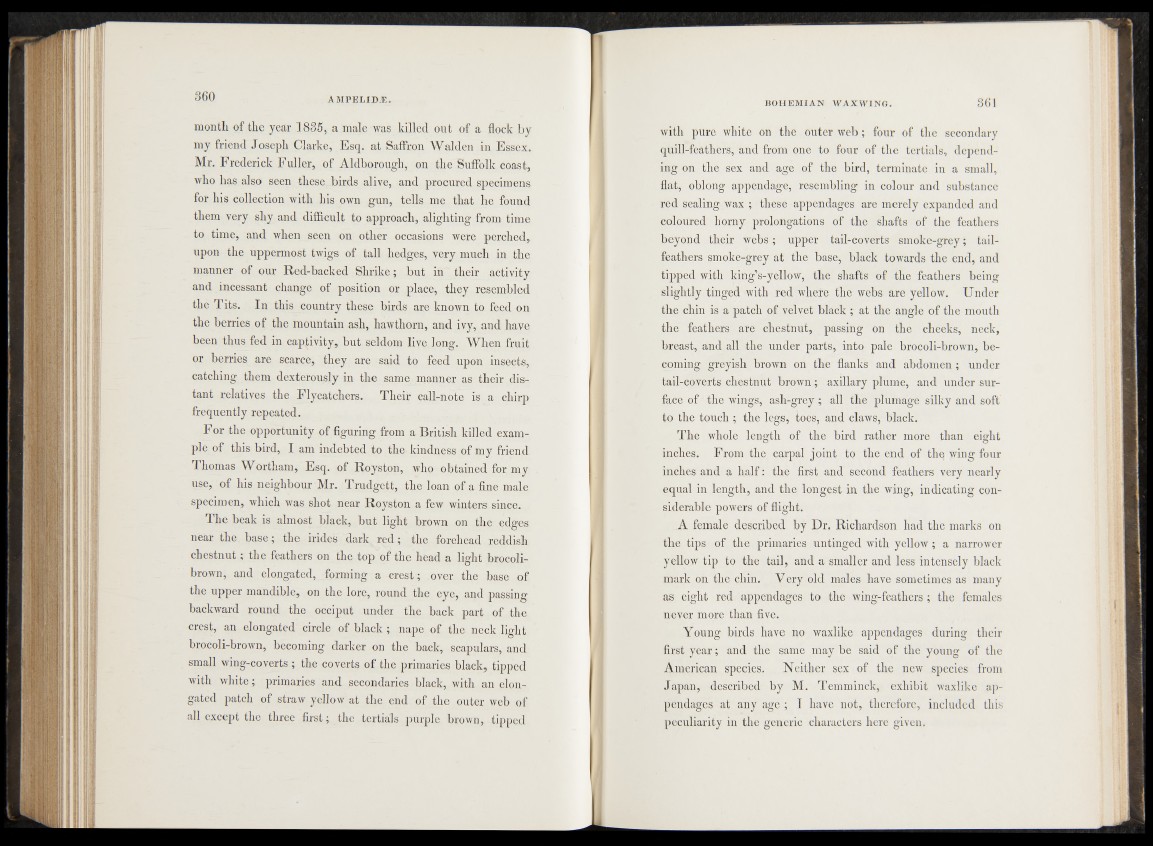
month of the year 1835, a male was killed out of a flock by
my friend Joseph Clarke, Esq. at Saffron Walden in Essex.
Mr. Frederick Fuller, of Aldborough, on the Suffolk coast,
who has also seen these birds alive, and procured specimens
for his collection with his own gun, tells me that he found
them very shy and difficult to approach, alighting from time
to time, and when seen on other occasions were perched,
upon the uppermost twigs of tall hedges, very much in the
manner of our Red-backed Shrike; but in their activity
and incessant change of position or place, they resembled
the Tits. In this country these birds are known to feed on
the berries of the mountain ash, hawthorn, and ivy, and have
been thus fed in captivity, but seldom live long. When fruit
or berries are scarce, they are said to feed upon insects,
catching them dexterously in the same manner as their distant
relatives the Flycatchers. Their call-note is a chirp
frequently repeated.
For the opportunity of figuring from a British killed example
of this bird, I am indebted to the kindness of my friend
Thomas Wortham, Esq. of Royston, who obtained for my
use, of his neighbour Mr. Trudgett, the loan of a fine male
specimen, which was shot near Royston a few winters since.
The beak is almost black, but light brown on the edges
near the base; the irides dark red; the forehead reddish
chestnut; the feathers on the top of the head a light brocoli-
brown, and elongated, forming a crest; over the base of
the upper mandible, on the lore, round the eye, and passing
backward round the occiput under the back part of the
crest, an elongated circle of black ; nape of the neck light
brocoli-brown, becoming darker on the back, scapulars, and
small wing-coverts ; the coverts of the primaries black, tipped
with white; primaries and secondaries black, with an elongated
patch of straw yellow at the end of the outer web of
all except the three first; the tertials purple brown, tipped
with pure white on the outer web; four of the secondary
quill-feathers, and from one to four of the tertials, depending
on the sex and age of the bird, terminate in a small,
flat, oblong appendage, resembling in colour and substance
red sealing wax ; these appendages are merely expanded and
coloured horny prolongations of the shafts of the feathers
beyond their webs; upper tail-coverts smoke-grey; tail-
feathers smoke-grey at the base, black towards the end, and
tipped with kingVyellow, the shafts of the feathers being
slightly tinged with red where the webs are yellow. Under
the chin is a patch of velvet black ; at the angle of the mouth
the feathers are chestnut, passing on the cheeks, neck,
breast, and all the under parts, into pale brocoli-brown, becoming
greyish brown on the flanks and abdomen ; under
tail-coverts chestnut brown; axillary plume, and under surface
of the wings, ash-grey; all the plumage silky and soft
to the touch ; the legs, toes, and claws, black.
The whole length of the bird rather more than eight
inches. From the carpal joint to the end of thq wing four
inches and a half: the first and second feathers very nearly
equal in length, and the longest in the wing, indicating considerable
powers of flight.
A female described by Dr. Richardson had the marks on
the tips of the primaries untinged with yellow; a narrower
yellow tip to the tail, and a smaller and less intensely black
mark on the chin. Very old males have sometimes as many
as eight red appendages to the wing-feathers ; the females
never more than five.
Young birds have no waxlike appendages during their
first year; and the same may be said of the young of the
American species. Neither sex of the new species from
Japan, described by M. Temminck, exhibit waxlike appendages
at any age ; I have not, therefore, included this
peculiarity in the generic characters here given.